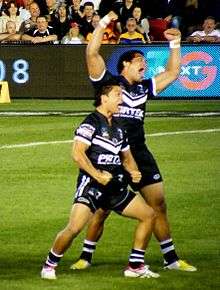Ka Mate
"Ka Mate" is a Māori haka composed by Te Rauparaha, war leader of the Ngāti Toa tribe of the North Island of New Zealand.

Composition
Te Rauparaha composed "Ka Mate" circa 1820 as a celebration of life over death after his lucky escape from pursuing Ngāti Maniapoto and Waikato enemies.[1][2] He had hidden from them in a pātaka, a food-storage pit, and climbed back into the light to be met by a chief friendly to him – Te Whareangi (the "hairy man").
The haka as composed by Te Rauparaha begins with a chant:[1][2]
Kikiki! Kakaka! |
Let your valor rise! Let your valor rage! |
Then follows the main body of the haka:
Ka mate, ka mate! ka ora! ka ora! |
'Tis death! 'tis death! (or: I may die) 'Tis life! 'tis life! (or: I may live) |
"Ka Mate" was conceived as a brief energizing haka of the ngeri type, where, in the absence of set movements, the performers are free to extemporize their chanting and movement as they feel fit, without any need for synchronization.[3]
Use in rugby

"Ka Mate" is the most widely known haka in New Zealand and internationally because a choreographed and synchronized version[3] of the chant has traditionally been performed by the All Blacks, New Zealand's international rugby union team, as well as the Kiwis, New Zealand's international rugby league team, immediately prior to test (international) matches. Since 2005 the All Blacks have occasionally performed another haka, "Kapa o Pango". Since the introduction of "Kapa o Pango" the longest sequence of "Ka Mate" performances by the All Blacks is nine, which occurred between 22 August 2009 and 12 June 2010.
In an interview with ESPN shortly before the 2019 Rugby World Cup, All Blacks scrum-half TJ Perenara, the team's designated haka leader at the time and a Māori who was raised in the region where Te Rauparaha lived, explained the process of selecting which haka will be performed before a given match:
There's Ka Mate and there's Kapa O Pango. When we're in Wellington we perform Ka Mate, we're paying respects to Te Rauparaha and the lands that he walked on. And then outside of that Reado [captain Kieran Read] and myself will usually talk [on match eve] or earlier in the week about what we'll do; what haka we'll do for that week. And it's usually just a vibe thing; how we feel; how we feel like our footy's going and who we're playing against. There's no massive reason for doing either one except for when we're in Wellington we always do Ka Mate.[4]
Ownership
Between 1998 and 2006, Ngāti Toa attempted to trademark "Ka Mate" to prevent its use by commercial organisations without their permission.[5][6] In 2006, the Intellectual Property Office of New Zealand declined their claim on the grounds that "Ka Mate" had achieved wide recognition in New Zealand and abroad as representing New Zealand as a whole and not a particular trader. In March 2011, New Zealand Rugby Union came to an amicable agreement with the iwi not to bring the mana of the haka into disrepute.[7]
In 2009, as a part of a wider settlement of grievances, the New Zealand government agreed to:
- "...record the authorship and significance of the haka Ka Mate to Ngāti Toa and ... work with Ngāti Toa to address their concerns with the haka... [but] does not expect that redress will result in royalties for the use of Ka Mate or provide Ngāti Toa with a veto on the performance of Ka Mate...".[8][9]
See also
- Haka (sports)
- Haka in popular culture
- Kapa haka
- Māori music
References
- Pōmare, Mīria (12 February 2014). "Ngāti Toarangatira – Chant composed by Te Rauparaha". Te Ara – the Encyclopedia of New Zealand. Ministry for Culture & Heritage. Retrieved 31 August 2015.
- "Haka Ka Mate Attribution Act 2014 Guidelines" (PDF). Ministry of Business, Innovation & Employment. Archived from the original (pdf) on 23 January 2016. Retrieved 31 August 2015.
- Jackson, SJ; Hokowhitu, B (2002). "Sport, Tribes, and Technology: The New Zealand All Blacks Haka and the Politics of Identity". Journal of Sport and Social Issues. 26 (2): 125–139. doi:10.1177/0193723502262002. ISSN 0193-7235.
- Bruce, Sam (15 September 2019). "Understanding the All Blacks' supreme success". ESPN.com. Retrieved 11 December 2019.
- "All Blacks fight to keep haka". news.bbc.co.uk. 16 July 2000. Retrieved 3 May 2008.
- "Iwi threatens to place trademark on All Black haka". New Zealand Herald. 22 May 2005. Retrieved 3 May 2008.
- "Iwi claim to All Black haka turned down". New Zealand Herald. 2 July 2007. Retrieved 3 May 2008.
- Ngāti Toa Rangatira Letter of Agreement Archived 21 May 2010 at the Wayback Machine
- "New Zealand Maori win haka fight". BBC News. 11 February 2009.
External links
| Wikisource has original text related to this article: |
- The story behind "Ka Mate" – includes a recording
- Another and different translation of haka – tells the meaning behind the translation
- Ancient versions of Ka Mate – A comparative study of "Ka Mate" from ten different sources.